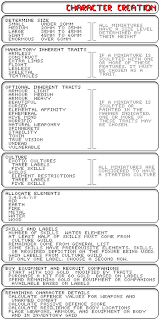Bring Your Own Miniatures - Character Development

Kill Team from Games Workshop seems to be getting a bit of traction, which is great. I'm really hoping to get a closer look at it in the next week, but for the moment, this Bring Your Own Miniatures project is focused on individual characters, and a few offsiders, rather than being focused on a team. So, I'll take a look at what they're doing, but concentrate my own efforts on something that's more like the old GW Inquisitor game. I know I've discussed the idea before, but there are various schools of thought about character development. I really thought about this long and hard when developing The Law, but in that game I ended up going with an open ended development system where a character could feasibly start physically weak, and end up as a muscle-bound powerhouse. For that game setting it makes sense; characters can be loaded up with cybernetics, genetically engineered, or become augmented in all different ways. For this game setting, I'm not so sure. ...







